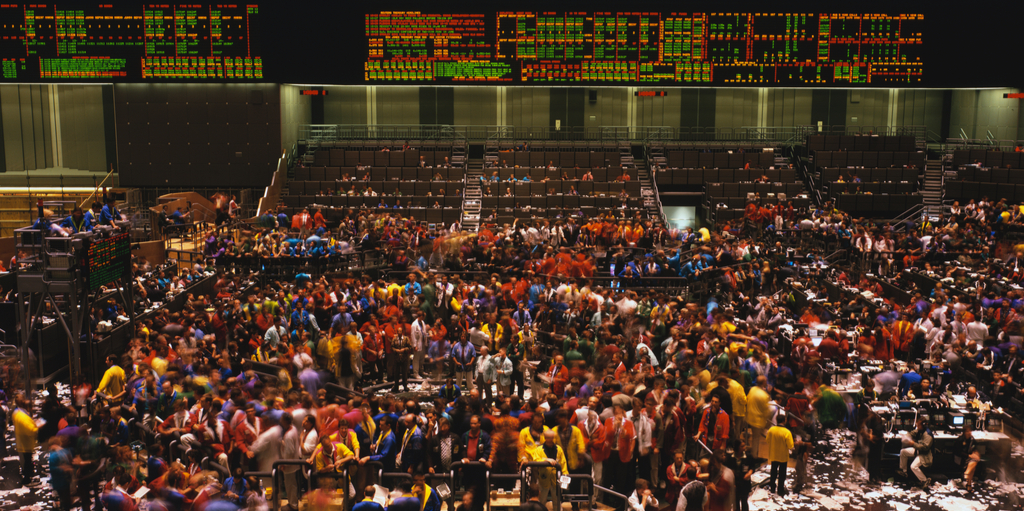Liberal thinkers used to be quite interested in this endeavor.
Commercial Civilization, Apollonian or Dionysian?
The Birth of Tragedy from the Spirit of Music (1872) is Friedrich Nietzsche’s first book. The hero is Dionysius, the Greek god of wine, who Nietzsche invokes as a wild principle of chaos, asymmetry, subversion, and violence. Nietzsche sets the Dionysian at odds with the Apollonian: balance and harmony, a cool and aloof geometry of order, the ethos of the Enlightenment. Nietzsche thinks you and I, residents in a commercial civilization, are altogether too stolid, security-conscious, and easily-pleased—desperately in need of Dionysian release.
The best place to look to understand commercial civilization remains the Scottish Enlightenment, which was the most important collective effort to explore the implications of the emerging industrial revolution. Despite such glaring differences, it is a curiosity then both Adam Smith and Nietzsche were drawn to similar imagery: Smith’s The Theory of Moral Sentiments opens with the image of a rope walker, as does Nietzsche’s most iconic book.
The Theory of Moral Sentiments is a classic of Enlightenment sensibility. It is such a good read because a barrage of examples drives the book forward. Here are the book’s first examples:
When we see a stroke aimed and just ready to fall upon the leg or arm of another person, we naturally shrink and draw back our own leg or our own arm; and when it does fall, we feel it in some measure, and are hurt by it as well as the sufferer. The mob, when they are gazing at a dancer on the slack rope, naturally writhe and twist and balance their own bodies, as they see him do, and as they feel that they themselves must do if in his situation.
By contrast to Smith, Thus Spoke Zarathustra is a classic of post-Enlightenment thinking. To some, it is the bible of nihilism, to others the whetstone of German nationalism, and to teenagers everywhere a companion to dreaming. When Zarathustra leaves his mountain and begins his ministry in the town below, he encounters a crowd gathered to watch a tight rope walker. The walker falls “like a vortex of legs and arms” and, whilst the crowd disperses for lack of entertainment, Zarathustra consoles the dying man, “you have made danger your calling, there is nothing in that to despise.” Vertigo and risk attract Nietzsche to this image.
Smith offers a softer and altogether less taut and catastrophic image than Nietzsche: spectators watching “a dancer,” keeping time with him through mimickry. The example is Apollonian and announces Smith’s signature thesis that sympathy—emotional harmony between persons—is the root of morality. The same balance is basic to business: commerce thrives on symmetries between desires and products.
Smith’s view appears to confirm Nietzsche’s assessment of us: altogether too placid. However, Smith and the logic of commercial civilization might be more subtle than Nietzsche appreciated.
We can find this subtlety in the twentieth century French intellectual, Roger Caillois (1913-1978), who expands The Birth of Tragedy into a social theory. Caillois was a founder of the short-lived but influential College of Sociology in Paris, an affiliation of writers before World War II who penned seminal studies on religion, festivals, play, and secret societies. He wrote consequential works on insects and stones but his most significant contribution is probably Man, Play and Games. There he turns to the classification of games to explore civilizations. We derive much of our moral and legal language from games, e.g. “that crosses the line,” but Caillois extends the point, arguing that classification reveals two different kinds of civilizations. He identifies four basic play categories: games of competition, chance, mimickry, and vertigo. Games in each, respectively, include boxing, roulette, dress-ups, and waltzing. These are just examples, there are literally dozens of games in each category.
Roman civilizations, Caillois goes on to argue, are marked by games of the first two kinds. These games foster “orderly societies with offices, careers, codes, and ready-reckoners.” Roman-type civilizations include the Incas, Assyrians, and Chinese—all civilizations Nietzsche would categorize as Apollonian. Dionysian or aboriginal civilizations—which include the Australian, American, and African—are marked by “simulation and vertigo or pantomime and ecstasy” fostered by the latter two sorts of games.
These two kinds of civilization don’t play well together. Caillois suggests that games with too hefty a dose of vertigo are unsustainable in our Roman civilization. Think only of the market panic of 2008 to see how destructive toying with vertigo is inside an otherwise Apollonian sensibility. The two great films about 2008, Margin Call and The Big Short, both capture the vertigo well.
The power of Caillois’ theory can be seen in this video of Peter Thiel skeptically discussing universities. Thiel is perplexed that our colleges are a weird hybrid of insurance and tournament. Enormous amounts of money are spent on higher education because families are really buying insurance, so their children do not fall through America’s pretty thin security net. However, universities are also a tournament where big score totals must be run up to knock others out of the game and secure the top spots in the insurance industry, elite colleges. Caillois shows this is not so very weird: the university is a dual game, competitively calibrating chance. Universities staff the offices of our Roman civilization with ready-reckoners and are fun places to be because a great game is being played.
However, we might not quite be the heirs of Rome that Caillois supposes. Smith’s slack rope example at the start of The Theory of Moral Sentiments is designed to support his claim that the economy is driven by mimickry. The desire to be the object of others’ sympathy—to be an object of their regard—is our heart’s desire, he contends, and the foundation of both commerce and morals. This explains why we spend money on the same attire as others, for being part of a club is to be morally affirmed in style, not just in the substance of our actions.
It is the mechanism behind fashion and design and how we all spend our money. Elites, Smith argues, set the fashion and are then copied by the rest of us. About the wages of “the meanest labourer” he writes: “If we examined his oeconomy with rigour, we should find that he spends a great part of them upon conveniences, which maybe be regarded as superfluities, and that, upon extraordinary occasions, he can give something even to vanity and distinction.”
To Smith’s mind, therefore, we are more Dionysian than either Nietzsche or Caillois appreciate. That said, we are Roman, too. Smith’s theory is that mimickry revolves around complex systems. I bear in my dominant hand an iPhone—a complex system—because you do. Identity and community (sympathy) are rooted in the elaborate Apollonian symmetries with which we adorn ourselves: watches, bags, shoes, clothes, sunglasses, cars, houses, etc. It is this adornment in complex systems, so as to play a part, that explains the distribution of wealth made by the invisible hand.
Using Caillois’ typology, in commercial civilization the Roman or Apollonian has the upper hand, as it dictates the nodes around which mimickry and the Dionysian play out. But on the other hand, it is mimickry that drives sales. The economy is one big pantomime, one where the tension between Apollonian and Dionysian forces never quite gets resolved.
It is worth thinking of Smith as a theorist mining the respective potencies of the two civilizational types. Much to Nietzsche’s chagrin, perhaps it is this blending of types that explains the resilience and reach of commercial life.



